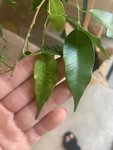So, in summary... yes, I am crazy to think this is mosaic virus.

Okay, I guess I won't toss it.
Many plant viruses can infect different plant species (including mosaic), and many are specific as
@Wires_Guy_wires points out. There are thousands of viral "species", just as in animal systems. So it is not illogical to consider viral infection (not necessarily mosaic) as a potential issue in bonsai, and maybe in this case.
There can be other causes to the symptoms you see, such as nutrition or plant pathogens such as mites or aphids (keeping in mind that mites and aphids also do speed viruses).
Viruses in plants can spread within a leaf and do not need to infect all the plant, creating a patterns as you see in your pictures, in some but not all leaves.
If an infected vector (such as an insect, as
@Leo in N E Illinois points out) forages on leaves of a species that can be used by the virus for replication, the infected cells are used for viral replication. Then, spread and infection of replicated viruses to nearby cells occurs via cell to cell channels, plasmodesmata, which are similar to gap junctions in animals, in terms that they allow the passage of molecules to surrounding cells.
Full plant infection does occur in viruses that can spread in the vascular system of an infected plant.
Another interesting aspect of the evolutionary history of plants and viruses is that plant specificity is also influenced by the vectors, the carriers of the viruses, which can be insect or in some cases pollen. If an insect has a specific plant host, or a set of plant species it uses for feeding or reproduction, It is also a logical evolutionary consequence for host pathogen interactions (plant-vector (insect)- pathogen(virus/fungus/bacteria/parasite) to develop.
I tend to see nutritional issues to affect many and not few leaves, in contrast to what you see, but
@Wires_Guy_wires has observed a similar symptoms from nutritional deficiency, and
@cbroad from mites, so you should see if that is the issue.
Some plant fungi can also use intracellular hyphae to spread via plasmodesmata.
You may not get the answer without sequencing or running some test such an Elisa. If you have the time an interest, here are some resources from UC Davies that don't need a lab to perform.
https://anrcatalog.ucanr.edu/pdf/8002.pdf
Have you noticed any changes in the trees since the last picture?
I would try to correct easy to resolve issues such as nutrition, but would do it in quarantine, just to be on the safe side in case it is a pathogen. That is what I personally do with my trees.










